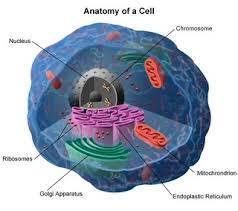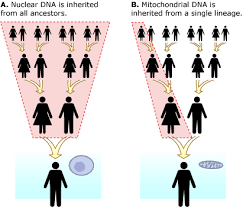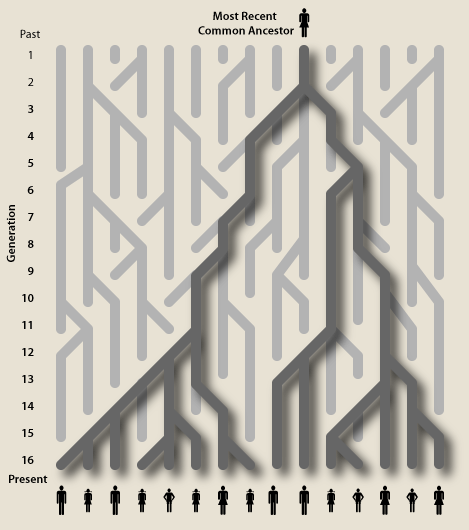Science for Authors: Mitochondrial DNA and Tracing your Ancestry #amwriting

Today I thought I'd delve a little into my own research and talk about mitochondrial DNA and tracing ancestry with it--both are quite a bit of fun, if I do say so myself! :) (*Just a note to say that while I teach many classes on mtDNA (mitochondrial DNA), this is a basic review for authors themselves, not meant for other uses.*)
 Okay, let's start off with the basics: what the heck is a mitochondria? Well, it's a small organelle in the cell (possibly incorporated into cells long, long ago in a symbiotic relationship, but that's a whole other story) and is often referred to as the "power house" of the cell. It makes the ATP, or energy, all cells in our bodies run on. Pretty important right? Well, it also has its own little genome--a small circular bit of DNA that it uses for purposes within the organelle, referred to as a mitogenoe (which I've always thought was kinda cute). It's this little piece of DNA that I allows us to trace human history through the female lineages of human history.
Okay, let's start off with the basics: what the heck is a mitochondria? Well, it's a small organelle in the cell (possibly incorporated into cells long, long ago in a symbiotic relationship, but that's a whole other story) and is often referred to as the "power house" of the cell. It makes the ATP, or energy, all cells in our bodies run on. Pretty important right? Well, it also has its own little genome--a small circular bit of DNA that it uses for purposes within the organelle, referred to as a mitogenoe (which I've always thought was kinda cute). It's this little piece of DNA that I allows us to trace human history through the female lineages of human history.There are some really unique features about mitochodrial DNA (mtDNA) that I should point out:
 It is inherited solely through the matriline, so everyone on earth has the same mtDNA as their mom, but only daughters will pass it along to the next generation (basically because sperm don't introduce any--or very little--mitochondria to the egg cell in fertilization).It mutates rapidly. Meaning that changes between mother and daughter's mtDNA happen more often than changes in nuclear DNA. This is mostly harmless (with a few exceptions), but allows for looking at differences between groups that are much more recent, as if there weren't any mutational differences, it would be really hard to tell groups/people apart based on their mtDNA.There are lots of copies per cell, which is really handy when working with old samples because more mtDNA copies means there's a higher chance of recovering the DNA to analyze it.There are lots of other interesting things about mtDNA, but I'll leave it at that for now :)
It is inherited solely through the matriline, so everyone on earth has the same mtDNA as their mom, but only daughters will pass it along to the next generation (basically because sperm don't introduce any--or very little--mitochondria to the egg cell in fertilization).It mutates rapidly. Meaning that changes between mother and daughter's mtDNA happen more often than changes in nuclear DNA. This is mostly harmless (with a few exceptions), but allows for looking at differences between groups that are much more recent, as if there weren't any mutational differences, it would be really hard to tell groups/people apart based on their mtDNA.There are lots of copies per cell, which is really handy when working with old samples because more mtDNA copies means there's a higher chance of recovering the DNA to analyze it.There are lots of other interesting things about mtDNA, but I'll leave it at that for now :)So, with mtDNA, it's possible to trace ancestry. Chances are, if you've sent in a spit-sample to trace your ancestry to one of the many companies that does this, they told you what mtDNA haplogroup you belong to. These haplogroups, lettered by the alphabet, are a way researchers have broken down the different lineages of mtDNA. I personally belong to haplogroup X2b2 (sounds much more mysterious than it really is :), which is found in some people of European ancestry, and spilt from a common maternal ancestor a long time ago to form the X branch that's also found in some Native American lineages--this happened way, way back when our ancestors were in the East Europe/Middle East region (with some debate about this).
 How do these haplogroups, or lineages, work?Well, as I mentioned, mtDNA mutates from time to time--meaning that at one of the base-pairs (the A,T,C, or G that makes up all DNA) spontaneously changes into one of the other bases. So, think of it this way: a mother has five daughters, and she passes along her mtDNA to each of them. But due to some random chance event, in one of her daughters, the mtDNA she passes along has a small change in it, so all the daughters and granddaughters from that line now carry a small difference. This mutation that happened splits the lineage, and it's possible that the mother and daughter would be placed in different (though related) haplogroups. It kind of works like a family tree, only with DNA.
How do these haplogroups, or lineages, work?Well, as I mentioned, mtDNA mutates from time to time--meaning that at one of the base-pairs (the A,T,C, or G that makes up all DNA) spontaneously changes into one of the other bases. So, think of it this way: a mother has five daughters, and she passes along her mtDNA to each of them. But due to some random chance event, in one of her daughters, the mtDNA she passes along has a small change in it, so all the daughters and granddaughters from that line now carry a small difference. This mutation that happened splits the lineage, and it's possible that the mother and daughter would be placed in different (though related) haplogroups. It kind of works like a family tree, only with DNA.Today, when we look at lots and lots of people's different mtDNA's, and the mutations they all have different from one another, it's possible to group them into lineages based on who all share the same mutations. These mutations can then be traced backwards through time, like the reverse of the mutation process in the previous paragraph: your direct maternal ancestors and relatives all share X mutations, but a larger group will share X-1 mutations because they're in a different branch, and so on back to the "root."
In humans, we can do this with all mtDNA to finally reach a single haplogroup that is found in Africa. Sometime a long time ago (based on how fast mtDNA mutates, probably about ~200kya), when modern humans first appeared, there was a small population with the same mtDNA haplotype, and this was passed along to all modern humans that live today. This is often confused with a single person who lived back then, referred to as mitochondrial Eve, though in reality it was probably a small group of people. By chance, one of the mitogenomes was the one that is now found in all humans, but plenty of nuclear DNA (in the nucleus of your cell) comes from many different ancestors, male and female, Neanderthal, and Denisovan, and probably a few other hominin species to boot! Still, it's pretty cool that it's possible to trace the matrilineal lineage of all modern humans to one spot and group!
Have you had your mtDNA or Y-chromosome DNA tested?
Published on February 05, 2018 04:00
No comments have been added yet.



